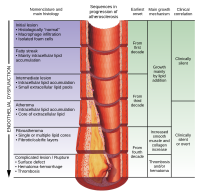
Photo from wikipedia
Cardiovascular disease (CVD) is a serious public health issue in China, accounting for more than 40% of all mortality, and it is the leading cause of death worldwide. Atherosclerosis is… Click to show full abstract
Cardiovascular disease (CVD) is a serious public health issue in China, accounting for more than 40% of all mortality, and it is the leading cause of death worldwide. Atherosclerosis is the pathological basis for much CVD, including coronary heart disease, acute myocardial infarction, and stroke. Endothelial dysfunction is an initiating and exacerbating factor in atherosclerosis. Recent research has linked oxidative stress and mitochondrial damage to endothelial dysfunction. Nuclear factor erythroid 2-related factor 2 (Nrf2) is a transcription factor with antioxidant effects that is strongly connected to several CVDs. However, the mechanism by which Nrf2 reduces CVD is unknown. Research indicates that Nrf2 improves endothelial function by resisting oxidative stress and mitochondrial damage, thereby delaying atherosclerosis. This article examines the mechanisms and potential targets of Nrf2 affecting endothelial cell function to improve atherosclerosis and to provide ideas for the development of new CVD treatments.
Journal Title: Cardiology Research and Practice
Year Published: 2022
Link to full text (if available)
Share on Social Media: Sign Up to like & get
recommendations!